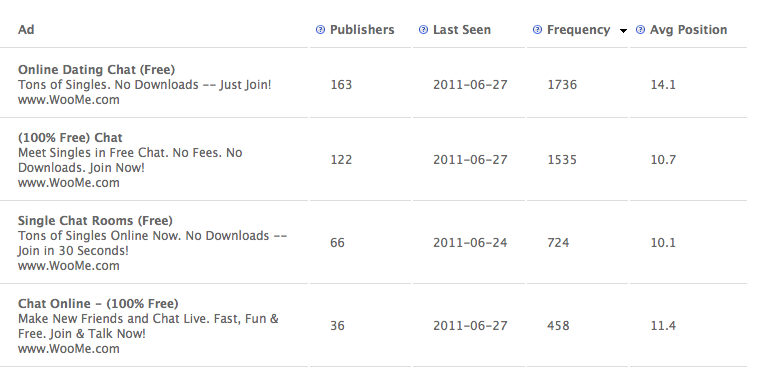 Online advertising is growing, and much of that growth is happening in display advertising. While search ads still make up 46 percent of the total over display’s 38 percent, display grew twice as fast as search in 2010. Many online businesses rely on advertising as a supplemental revenue stream in support of their business model — if not the sole source — especially from AdSense. As such, companies and startups spend a lot of time testing out different ad iterations, looks, and copy in an effort to find the most clickable ad content and the most lucrative campaigns. And, interestingly, relatively tiny tweaks to wording and content in ads can have a fairly dramatic effect on clickthrough rates, increasing them as much as tenfold.
Online advertising is growing, and much of that growth is happening in display advertising. While search ads still make up 46 percent of the total over display’s 38 percent, display grew twice as fast as search in 2010. Many online businesses rely on advertising as a supplemental revenue stream in support of their business model — if not the sole source — especially from AdSense. As such, companies and startups spend a lot of time testing out different ad iterations, looks, and copy in an effort to find the most clickable ad content and the most lucrative campaigns. And, interestingly, relatively tiny tweaks to wording and content in ads can have a fairly dramatic effect on clickthrough rates, increasing them as much as tenfold.
A lot of businesses end up losing valuable time and money trying out different wordings and approaches, which is why MixRank, a startup out of the latest class of Y Combinator companies, is today launching a competitive intelligence service that clues businesses into how successful the AdSense display and contextual advertising of other companies (read: their competitors) has been. If, for example, your business is advertising a similar product to another company in the space, MixRank allows users to skip past the some 80 percent of ads that lose money, and view the methods of attack that are working for their competitors. Users can also view the sites that are directing the most traffic to their competitors.
To make this possible, MixRank has effectively created a search engine for AdSense that crawls pages running Google ads, and since Google sorts these ads by effectiveness, MixRank indexes this data and estimates ad performance. After crawling these pages, MixRank takes into account Google’s sorting of the ads by effectiveness, then uses this data to serve essential performance analytics.
As you can get a sense from the image above, MixRank’s service yields a ton of interesting data for advertisers. Using MixRank’s dashboard, users can see that, of the different wordings WooMe is testing for their Google ads, the top phrasing has been far more successful than the other pilots. As advertisers employ different calls to action in their advertising, these businesses can now get a better sense of whether using immediacy, scarcity, or time limits, etc will be more effective in selling their products. Users can quickly test these different calls and easily see what’s working.
As one can see in this example of Gillette advertising, the most successful ads don’t target sites that have the same theme as the product they’re hawking, but instead using common cases, problems, and questions to address their potential customers. The top Gillette ad for deodorant is “Interview with confidence”, for example.
Mixrank Co-founder Ilya Lichtenstein, whose background is in affiliate marketing, told us that many of the seemingly pervasive daily deals sites out there all essentially play “follow the leader” when it comes to advertising (as they seem to do with business models and more). Many of the smaller sites can’t compete with the leaders like Groupon and LivingSocial, because they don’t have the resources to build a large team of salespeople, researchers, and copywriters, so they find the easiest ways to mimic the leaders.
So, because it’s true that, in any highly competitive market with thin margins, there are usually only a few ads or traffic sources that resonate with customers and get big CTRs, MixRank levels the playing field. It allows smaller businesses access to the same copy, content, testing and comparative analysis that the big boys utilize; smaller operations can see where their competitors are buying ad real estate and view what type of ad copy is working best.
Thanks to Cofounder Scott Milliken, who built most of MixRank’s architecture, the service currently indexes 93,000 sites using Google AdSense, and that number continues to grow every day. One might, of course, assume that a caveat to MixRank’s business might be intrinsic to scaling and adoption, but even as more and more businesses sign up to use the service, it seems that ads will only become more efficient at a faster rate, as each team learns from another’s experiments. And, in the end, that could be better for consumers, too.
MixRank is completely free at this point, as it tests the market to see what kind of adoption it will see, but Lichtenstein told me he has plans to eventually implement a subscription model (an affordable monthly one) to monetize. And big picture plans include building a model of the whole display market, which may eventually include machine learning to work towards building a prediction engine that can tell users which particular version of a campaign might be the most successful.
It’s a deceptively simple concept, but a very interesting one, so check it out, and let us know what you think.
